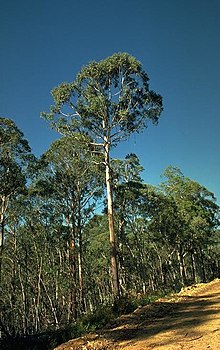Eucalyptus delegatensis
| Alpine ash | |
|---|---|

| |
| Eucalyptus delegatensis growing between Corryong and Omeo | |
| Scientific classification | |
| Kingdom: | Plantae |
| Clade: | Tracheophytes |
| Clade: | Angiosperms |
| Clade: | Eudicots |
| Clade: | Rosids |
| Order: | Myrtales |
| Family: | Myrtaceae |
| Genus: | Eucalyptus |
| Species: | E. delegatensis
|
| Binomial name | |
| Eucalyptus delegatensis | |
Eucalyptus delegatensis, commonly known as alpine ash, gum-topped stringybark, white-top[3] and in Victoria as woollybutt,[4] is a species of tree that is endemic to southeastern Australia. It has a straight trunk with rough, fibrous to stringy bark on the lower half of the trunk, smooth white bark above, lance-shaped to curved adult leaves, flower buds in groups of between seven and fifteen, white flowers and barrel-shaped or hemispherical fruit.



Description
Eucalyptus delegatensis is a tree that typically grows to a height of 40–50 m (130–160 ft), sometimes to 90 m (300 ft), and forms a
Taxonomy and naming
Eucalyptus delegatensis was first formally described in 1900 by Richard Thomas Baker from a specimen collected by William Baeuerlen, (previously known as Wilhelm Bäuerlen) on "Delegate Mountain". The description was published in Proceedings of the Linnean Society of New South Wales.[8][9] The specific epithet (delegatensis) refers to the type location.[3]
In 1985 Douglas John Boland described two subspecies and the names have been accepted by the Australian Plant Census:
- Eucalyptus delegatensis R.T.Baker subsp. delegatensis[10] that has broadly lance-shaped juvenile leaves and is found in New South Wales and Victoria;
- Eucalyptus delegatensis subsp. tasmaniensis Boland[11] that has more or less round juvenile leaves with a short "drip-tip" and only grows in Tasmania.[12]
Distribution and habitat
Alpine ash is widespread and often dominant in grassy or wet
See also
References
- . Retrieved 23 October 2021.
- ^ "Eucalyptus delegatensis". Australian Plant Census. Retrieved 28 May 2019.
- ^ a b c "Eucalyptus delegatensis subsp. delegatensis". Euclid: Centre for Australian National Biodiversity Research. Retrieved 4 June 2020.
- ^ Second paragraph of Boland, Douglas J. (1985). "Taxonomic revision of Eucalyptus delegatensis R.T.Baker (Myrtaceae)". Australian Forest Research. 15: 173–181. Retrieved 28 May 2019.
- ^ Chippendale, George M. "Eucalyptus delegatensis". Australian Biological Resources Study, Department of the Environment and Energy, Canberra. Retrieved 28 May 2019.
- ^ a b Hill, Ken. "Eucalyptus delegatensis". Royal Botanic Garden Sydney. Retrieved 28 May 2019.
- ^ a b Brooker, M. Ian; Slee, Andrew V. "Eucalyptus delegatensis subsp. delegatensis". Royal Botanic Gardens, Victoria. Retrieved 28 May 2019.
- ^ "Eucalyptus delegatensis". APNI. Retrieved 28 May 2019.
- . Retrieved 28 May 2019.
- ^ "Eucalyptus delegatensis subsp. delegatensis". Australian Plant Census. Retrieved 28 May 2019.
- ^ "Eucalyptus delegatensis subsp. tasmaniensis". Australian Plant Census. Retrieved 28 May 2019.
- ^ Boland, Douglas J. (1985). "Taxonomic revision of Eucalyptus delegatensis R.T.Baker (Myrtaceae)". Australian Forest Research. 15: 173–181. Retrieved 28 May 2019.

